Throughout North Carolina communities have welcomed electric-scooters (e-scooters) as a convenient alternative mode of transportation due to their social, health, and environmental benefits; enhanced community connectivity, and positive economic impact. As scooters continue to gain popularity in North Carolina, we have unfortunately seen a corresponding increase in scooter-related accidents. Given the complex nature of these incidents, understanding how scooter accident claims work is crucial for victims seeking compensation.
This guide serves to unravel the complexities of the legal process, shedding light on when and how to file a claim, the role of insurance companies, and the importance of legal representation.
The Prevalence of Scooter Accidents in North Carolina
In recent years, North Carolina has seen a significant surge in the use of scooters as a mode of transportation. This has led to an alarming increase in scooter-related accidents across the state. These accidents can result in severe injuries or even fatalities due to the lack of protection scooters provide to their riders.
Some of the top injury and fatality risks for e-scooter riders include unsafe road surface conditions, collisions with motor vehicles, and low visibility. According to a report by the U.S. Consumer Product Safety Commission, the number of e-scooter related emergency room visits rose from 7,700 in 2017 to 42,200 in 2021. This disturbing surge in injuries highlights the critical need for safety measures and regulations.
Understanding Who Rides E-Scooters and Where
According to a study by the Behavioral Traffic Safety Cooperative Research Program, those who use e-scooters are generally aged 18-34 and predominantly live in urban areas. This demographic alignment may be connected to the proliferation of shared e-scooter programs such as Lime, Bird, Spin and others.
These programs are prominently featured in downtown districts and college campuses, both of which host a diverse array of businesses, including, shops, restaurants, cafes, markets, as well as an assortment of entertainment options including museums, theaters, art galleries, music venues, and sports facilities.
However, scooter accidents aren’t confined to these areas alone. As scooter usage expands to suburban and rural areas, the potential for accidents does too. Therefore, understanding how scooter accident claims work becomes crucial to ensure victims can seek appropriate compensation for their injuries and losses.
Understanding Scooter Accident Claims
A scooter accident claim refers to a legal claim in which an individual seeks compensation for the injuries, damages, or losses they’ve sustained in an accident involving a scooter. E-scooter accident claims typically arise when a person is involved in a collision, falls, or suffers harm due to the use of a scooter, whether as a rider, pedestrian, or other affected individual. It is essentially a subset of personal injury law, where the injured party files a claim against the at-fault party’s insurance company.
The responsible party can include other drivers, pedestrians, or even the scooter manufacturer or rental company, depending on the cause of the accident. These claims can cover a range of damages, such as medical bills, lost wages, property damage, and even emotional distress.
To successfully file a scooter accident claim, it’s essential to understand the concept of negligence. Negligence in personal injury law refers to a party’s failure to act with the level of care that a reasonable person would have under the same circumstances. If the other party’s negligence led to the accident, they could be held liable for the victim’s injuries and damages. Thus, proving negligence is a key aspect of any scooter accident claim.
Determining Liability
The legal avenues for compensation vary depending on whether you are the scooter rider who got injured or a party injured due to a scooter accident. For scooter riders, if the accident occurs due to another party’s negligence—such as a careless driver or a reckless pedestrian—the scooter rider can file a claim against the negligent party’s insurance.
On the flip side, if a pedestrian or another party is injured due to a scooter rider’s negligence, they may seek compensation by filing a claim against the rider. In some instances, the scooter company could also be held liable, especially if there was a defect with the scooter that contributed to the accident. Because these scenarios can be complex, it’s always advisable to consult with a personal injury lawyer to understand the appropriate course of action.
When to File a Scooter Accident Claim
Timing is a crucial factor when it comes to filing a scooter accident claim. In North Carolina, the statute of limitations for personal injury cases, including scooter accidents, is generally three years from the date of the accident. This means victims have a three-year window to file a lawsuit seeking compensation for their injuries. Filing a claim outside this period can result in the case being dismissed, barring a few exceptions.
Steps to Take after a Scooter Accident
- Seek Medical Attention: If injuries are sustained, prioritize your health and safety. Seeking prompt medical attention is essential. Medical records, doctor’s assessments, and treatment plans provide documentation of the injuries and their impact on the injured party’s health and well-being.
- Document the Scene: If you are physically able to do so, gather evidence at the accident scene. Take photos of the e-scooter, any vehicles involved, the surrounding area, and your injuries. Note any relevant details such as road conditions, weather, and traffic signals.
- Obtain Witness Information: If there are witnesses to the accident, collect their names and contact information. Their statements may be valuable in supporting your claims. Check for presence of nearby video recording devices, like store security cameras, which may have recorded the accident. Gather details about the camera’s placement and ownership, and if feasible, acquire the recorded video footage.
- Report the Incident: Contact local law enforcement to report the accident. An official police report can provide crucial details and documentation of the incident.
- Keep a record of Expenses: After an accident, it is important to keep a detailed record of all related expenses. Obtain copies of receipts, bills, invoices and/or estimates for medical treatment, prescription medications, medical equipment (crutches, braces, etc.), property damage repairs or replacements (vehicles, jewelry, clothing, etc.) income lost due to missed work, transportation costs, and any other out-of-pocket expenses incurred as a direct result of the accident.
How to File a Scooter Accident Claim
Filing a scooter accident claim begins with gathering all the necessary documentation related to the accident. This includes a police report, witness statements, photographs of the accident scene, and records of medical treatment received as a result of the accident. It’s also crucial to keep a detailed account of all expenses incurred, including medical bills, property damage, and lost wages. All these pieces of evidence can greatly support your claim and help demonstrate the extent of your losses.
As you collect and obtain documentation, the next step is to file the claim with the at-fault party’s insurance company. In cases where injuries are linked to a rented/shared e-scooter, the claim should be reported to the e-scooter company. You can typically report a claim by phone, online through the insurance company’s or e-scooter company’s website, or through a mobile app. The entity where you submit your claim will request key details about the accident, including the date, time and location of the incident, description of what transpired, information about the parties involved, details of the injuries sustained, the treatment received, and the relevant police report number.
After the claim is filed, the insurance company or e-scooter company will investigate the claim and, typically, make a liability decision and/or propose a settlement offer. Often if an offer of settlement is made at all, the amount is significantly lower than what a victim might be entitled to receive. A personal injury attorney can help negotiate a fair settlement.
Obtain Legal Representation Early
Seeking legal advice at the earliest opportunity after an accident is vital. Legal representation provides several important advantages and safeguards your rights and interests.
- Understanding Rights: A legal professional can explain your rights and options based on the specific circumstances of your situation. This powerful knowledge ensures you make informed decisions and do not make costly mistakes..
- Preserving Evidence: Lawyers can guide you on collecting and preserving crucial evidence, which is necessary for building a strong case. In some instances, particularly with video recordings, failing to preserve or secure evidence soon after an accident can result in the evidence deteriorating, being overwritten, and ultimately becoming irretrievable.
- Eye Witness Interviews: Witness statements are a form of evidence preservation. Obtaining witness statements near or at the time of the accident is crucial because memories are most accurate and detailed when the events are recent. Waiting can lead to fading recollections, potential biases, and difficulty reaching witnesses.
- Navigating Complex Laws: Legal professionals have a deep understanding of the law and can help you navigate complex legal processes, ensuring you adhere to deadlines and requirements.
- Negotiating Power: Attorneys can negotiate with insurance companies, other parties involved, or their legal representatives to secure the best possible settlement or outcome.
- Maximizing Compensation: A lawyer can assess the full extent of your damages, including hidden recoverable expenditures, and help you pursue appropriate compensation.
- Avoiding Mistakes: Legal guidance minimizes the risk of making errors or inadvertently compromising your case by providing advice on what to disclose and not to disclose, how to frame your statements, and how to proceed.
- Confidence in Decisions: With legal advice, you’ll have the confidence that you’re making the right choices throughout the process.
- Lawsuit Leverage: Frequently, in the absence of the possibility of a legal action, responsible parties may be less inclined to address the needs of the victims appropriately. This leads to a lack of responsiveness, delayed or insufficient communications, and even an outright refusal to provide fair or any form of compensation for damages. The prospect of legal action compels these parties to take the situation seriously. This leverage serves as motivation for them to engage in discussions, assess their liability, and consider the legal implications of not reaching a reasonable settlement.
- Representation in Court: If it is necessary to file a lawsuit and go to court, having an attorney by your side ensures proper representation and advocacy.
Bradford Law Can Help If You’ve Been Injured in a Scooter Accident
Understanding and navigating scooter accident claims can be a complex process, but with the right legal support, victims can effectively pursue the compensation they deserve. If you’ve been injured in a scooter accident, it’s critical to take timely action and seek professional legal help. At Bradford Law we are well-versed in scooter accident claims and are ready to assist you in your journey towards justice. Contact us today for a free consultation and take the first step in securing the best possible outcome for your case.



